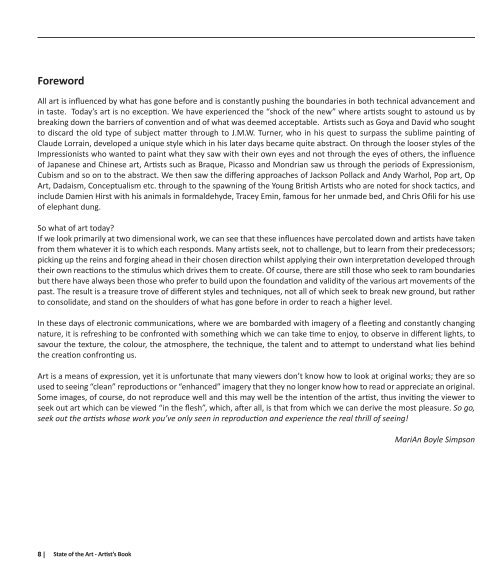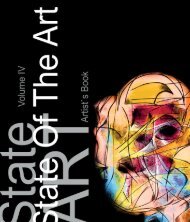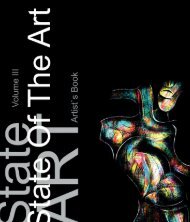State of the Art_Artists Book
Livro de Arte
Livro de Arte
You also want an ePaper? Increase the reach of your titles
YUMPU automatically turns print PDFs into web optimized ePapers that Google loves.
Foreword<br />
All art is influenced by what has gone before and is constantly pushing <strong>the</strong> boundaries in both technical advancement and<br />
in taste. Today’s art is no exception. We have experienced <strong>the</strong> “shock <strong>of</strong> <strong>the</strong> new” where artists sought to astound us by<br />
breaking down <strong>the</strong> barriers <strong>of</strong> convention and <strong>of</strong> what was deemed acceptable. <strong>Art</strong>ists such as Goya and David who sought<br />
to discard <strong>the</strong> old type <strong>of</strong> subject matter through to J.M.W. Turner, who in his quest to surpass <strong>the</strong> sublime painting <strong>of</strong><br />
Claude Lorrain, developed a unique style which in his later days became quite abstract. On through <strong>the</strong> looser styles <strong>of</strong> <strong>the</strong><br />
Impressionists who wanted to paint what <strong>the</strong>y saw with <strong>the</strong>ir own eyes and not through <strong>the</strong> eyes <strong>of</strong> o<strong>the</strong>rs, <strong>the</strong> influence<br />
<strong>of</strong> Japanese and Chinese art, <strong>Art</strong>ists such as Braque, Picasso and Mondrian saw us through <strong>the</strong> periods <strong>of</strong> Expressionism,<br />
Cubism and so on to <strong>the</strong> abstract. We <strong>the</strong>n saw <strong>the</strong> differing approaches <strong>of</strong> Jackson Pollack and Andy Warhol, Pop art, Op<br />
<strong>Art</strong>, Dadaism, Conceptualism etc. through to <strong>the</strong> spawning <strong>of</strong> <strong>the</strong> Young British <strong>Art</strong>ists who are noted for shock tactics, and<br />
include Damien Hirst with his animals in formaldehyde, Tracey Emin, famous for her unmade bed, and Chris Ofili for his use<br />
<strong>of</strong> elephant dung.<br />
So what <strong>of</strong> art today?<br />
If we look primarily at two dimensional work, we can see that <strong>the</strong>se influences have percolated down and artists have taken<br />
from <strong>the</strong>m whatever it is to which each responds. Many artists seek, not to challenge, but to learn from <strong>the</strong>ir predecessors;<br />
picking up <strong>the</strong> reins and forging ahead in <strong>the</strong>ir chosen direction whilst applying <strong>the</strong>ir own interpretation developed through<br />
<strong>the</strong>ir own reactions to <strong>the</strong> stimulus which drives <strong>the</strong>m to create. Of course, <strong>the</strong>re are still those who seek to ram boundaries<br />
but <strong>the</strong>re have always been those who prefer to build upon <strong>the</strong> foundation and validity <strong>of</strong> <strong>the</strong> various art movements <strong>of</strong> <strong>the</strong><br />
past. The result is a treasure trove <strong>of</strong> different styles and techniques, not all <strong>of</strong> which seek to break new ground, but ra<strong>the</strong>r<br />
to consolidate, and stand on <strong>the</strong> shoulders <strong>of</strong> what has gone before in order to reach a higher level.<br />
In <strong>the</strong>se days <strong>of</strong> electronic communications, where we are bombarded with imagery <strong>of</strong> a fleeting and constantly changing<br />
nature, it is refreshing to be confronted with something which we can take time to enjoy, to observe in different lights, to<br />
savour <strong>the</strong> texture, <strong>the</strong> colour, <strong>the</strong> atmosphere, <strong>the</strong> technique, <strong>the</strong> talent and to attempt to understand what lies behind<br />
<strong>the</strong> creation confronting us.<br />
<strong>Art</strong> is a means <strong>of</strong> expression, yet it is unfortunate that many viewers don’t know how to look at original works; <strong>the</strong>y are so<br />
used to seeing “clean” reproductions or “enhanced” imagery that <strong>the</strong>y no longer know how to read or appreciate an original.<br />
Some images, <strong>of</strong> course, do not reproduce well and this may well be <strong>the</strong> intention <strong>of</strong> <strong>the</strong> artist, thus inviting <strong>the</strong> viewer to<br />
seek out art which can be viewed “in <strong>the</strong> flesh”, which, after all, is that from which we can derive <strong>the</strong> most pleasure. So go,<br />
seek out <strong>the</strong> artists whose work you’ve only seen in reproduction and experience <strong>the</strong> real thrill <strong>of</strong> seeing!<br />
MariAn Boyle Simpson<br />
8 | <strong>State</strong> <strong>of</strong> <strong>the</strong> <strong>Art</strong> - <strong>Art</strong>ist’s <strong>Book</strong>






